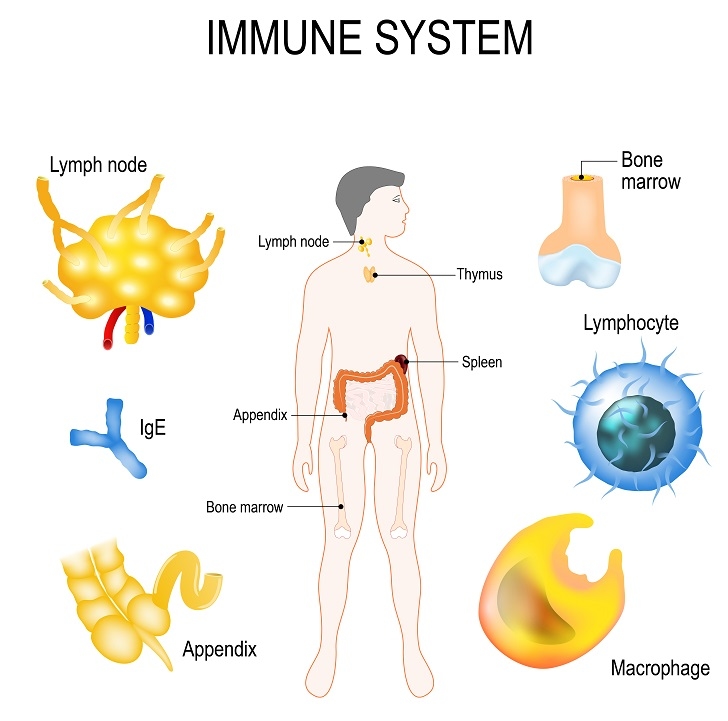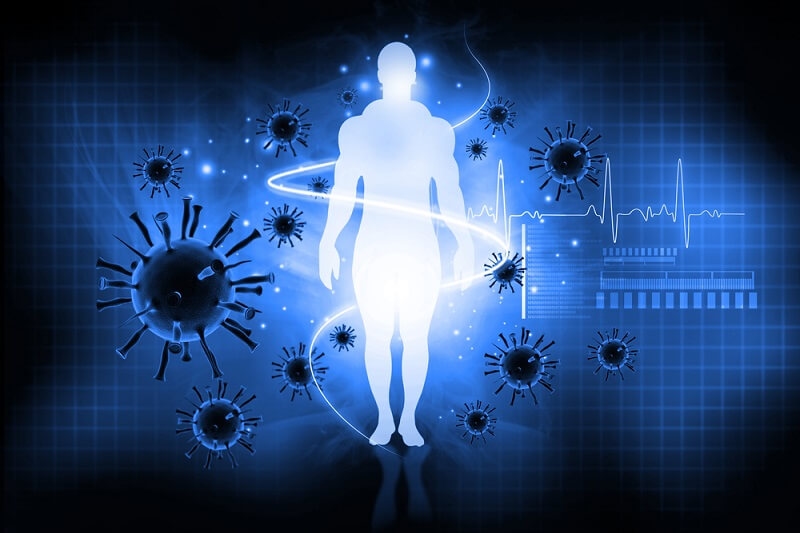The Immune System: A Working Defense For Your Health

Our bodies are designed to have qualities like mobility and strength in the external environment. This means that we are made up of numerous systems to help us function better. Our immune system is specialized in guarding us against invaders like microscopic pathogens, rogue cells, and much more. Understanding and nurturing this vital system is crucial for maintaining optimal health. Lets venture into the depths of the immune system and explore the detailed working. Learning what supports our immune system and what does not is crucial.
What is the immune system?

Specific tissues, cells, and organs come together to create a harmonious working of the immune system. The aim of this teamwork done by the parts of our body is to protect it from potentially harmful invaders and external troubles. Imagine an army of cells that are frontiers to the line of defense created for identifying and eliminating threats. They primarily have an active presence in the bloodstream seeking bacteria and viruses, fungi, parasites, and cancer cells. There are two types of immune systems:
Innate vs. Acquired Immunity
1. Innate immune system
This represents the body's initial, rapid-response defense mechanism against various pathogens. The natural immune system comprises physical barriers like the skin, mucous membranes, and different white blood cells such as neutrophils and macrophages. It provides immediate but nonspecific protection, serving as a critical first line of defense by rapidly recognizing and attempting to neutralize any foreign invaders it encounters.
2. Acquired immune system
This system, also called the adaptive immune system, offers a highly specialized and specific form of protection. This system relies on specialized white blood cells called lymphocytes, specifically T and B cells, uniquely identifying and remembering particular pathogens. Upon encountering a pathogen, the acquired immune system generates antibodies by B cells and activating killer T cells to eliminate the specific threat. This system retains a memory of past encounters, enabling the body to quicken an effective response if it reencounters the same pathogen in the future.
Infections Spreading Explained
Pathogens employ various means to spread, and understanding these mechanisms is crucial for devising effective preventive strategies. Direct contact, respiratory droplets from coughing or sneezing, and contaminated surfaces all contribute to the transmission of infections. By comprehending how infections spread, individuals can adopt proper hygiene practices, vaccination, and social distancing measures to mitigate these risks.
What does the immune system do?
The process of how the immune system works is intricate and coordinated. When a pathogen enters the body, it's recognized as foreign by specific receptors on immune cells. These receptors trigger responsive events, including the production of antibodies, the activation of killer cells, and the release of cytokine signaling molecules. These actions work together to eliminate the invader and create an immune memory that helps the body respond faster and more effectively if the same pathogen returns. The immune system has a nature of registering an experience with every external organism and utilizing it to the advantage of fulfilling the protection purpose.
What is the immune system comprised of?

1. First Line of Defense
The skin, our body's largest organ, serves as an impenetrable barrier preventing the entry of pathogens. Mucous membranes lining the respiratory, digestive, and other tracts provide an additional layer of defense. Chemical reasons, such as enzymes and antimicrobial substances, reinforce these barriers. Enzymes like lysozyme can break down the cell walls of bacteria, while antimicrobial peptides create an inhospitable environment for pathogens.
2. Lymphatic System
The lymphatic system, often called the body's second circulatory system, consists of lymph nodes, vessels, and organs. Lymph, a fluid containing immune cells, travels through this network. Lymph nodes act as filtration centers where immune cells inspect the lymph for pathogens. The spleen, another crucial component, filters blood and removes damaged red blood cells, while the tonsils play a role in detecting and responding to pathogens entering the mouth and nose.
3. Antigens and Antibodies
Antigens are like the "wanted pathogens " posters. These molecules, present on the surface of bacteria, viruses, and other invaders, trigger an immune response. Antibodies, produced by B cells, are the immune system's precision weapons. Each antibody is specific to a particular antigen, and its role is to recognize, bind to, and neutralize the invading pathogens. This targeted response prevents the spread of infection.
4. Bone Marrow and Thymus
Bone marrow, found in the cavities of bones, is the primary site of blood cell production. Hematopoietic stem cells in the bone marrow give rise to various blood cells, including B cells. The thymus, located above the heart, is crucial for the maturation of T cells. T cells play a central role in coordinating the immune response, and their education in the thymus ensures they can distinguish between self and non-self, preventing autoimmune reactions.
5. White Blood Cells
White blood cells (WBCs) are diverse and versatile soldiers in the immune army. Neutrophils are rapid responders, first on the scene to engulf and destroy pathogens. Lymphocytes, comprising B and T cells, contribute to the specific and long-lasting aspects of immunity. When they leave the bloodstream and mature into macrophages, monocytes become efficient scavengers, clearing cellular debris and pathogens away. They are the front liners dealing with problems like allergies.
6. Phagocytes
Phagocytes, including macrophages and neutrophils, are the "Pac-Men" of the immune system. They engulf and digest pathogens through a process called phagocytosis. Macrophages in tissues act as sentinels, while neutrophils are the first responders to infections. This process not only eliminates pathogens but also contributes to the activation of other immune cells.
7. Basophils and Mast Cells
Basophils and mast cells release histamine and other chemicals, initiating inflammation. While inflammation is a protective response, helping to eliminate pathogens, excessive or chronic inflammation can contribute to various diseases. These cells are essential for the immediate, localized response to infection or injury.
8. Secondary Lymph Organs
Lymph nodes, spleen, and tonsils are secondary lymphoid organs where immune cells congregate and interact. Lymph nodes filter lymph, trapping pathogens for inspection by immune cells. The spleen filters blood, removing damaged cells and pathogens. Tonsils, strategically positioned in the throat, are an early warning against pathogens entering the mouth and nose.
9. Memory Cells
Memory cells, B and T cells, are the immunological historians of the body. After an infection, a pool of memory cells is retained, "remembering" the specific pathogen. Upon re-exposure, these memory cells mount a rapid and potent response, preventing or mitigating the severity of the infection. This memory function is the foundation of the effectiveness of vaccines. These cells effectively come to aid in fighting conditions like diabetes.
10. Cytokines
These are signaling proteins that orchestrate the immune response, acting as messengers between immune cells. They regulate inflammation, stimulate the production of immune cells, and coordinate the overall defense strategy. Cytokines ensure that different components of the immune system work in harmony, responding appropriately to the nature and severity of the threat.
What Conditions And Disorders Affect The Immune System?
- The immune system's efficiency can be compromised by various factors, leading to conditions and disorders that impact overall health.
- Autoimmune diseases occur when the immune system mistakenly attacks the body's cells and tissues. This includes dealing with conditions like rheumatoid arthritis, lupus, and multiple sclerosis.
- Immunodeficiency disorders result in a weakened or absent immune response, making individuals more susceptible to infections. Primary immunodeficiencies are often genetic, while secondary immunodeficiencies may be acquired due to factors like different types of cancer, HIV infection, or certain medications.
- Chronic stress has been linked to immune system suppression, highlighting the intricate connection between mental health and immune function.
Immunoglobulin Therapy

Immunoglobulin therapy, also known as IVIG (intravenous immunoglobulin), is a medical treatment that involves infusing a patient with concentrated antibodies derived from the blood plasma of healthy donors. These antibodies are known to relieve people who have certain immune system disorders or conditions like:
Immunodeficiency Disorders
Patients with primary immunodeficiency disorders, whose immune systems cannot produce sufficient antibodies, can receive immunoglobulin therapy to bolster their immune defenses. This is specifically targeted at those people who find it extremely difficult to handle their immunodeficiencies through lifestyle choices.
Autoimmune Diseases
In some autoimmune conditions, such as Guillain-Barr syndrome and myasthenia gravis, immunoglobulin therapy can help modulate the immune response and reduce symptoms. Such disorders carry potential risks of making the body prone to other infections, further weakening the body's defense.
Neurological Conditions
There's growing interest in using immunoglobulin therapy to treat certain neurological disorders, including chronic inflammatory demyelinating polyneuropathy (CIDP) and multifocal motor neuropathy. The immune system highly affects how our mind functions, making it a significant relationship in the entire body.
Infections
Immunoglobulin therapy can be used as a passive immunization against specific diseases, particularly in cases where the patient's immune system is compromised or unable to produce antibodies quickly enough.
Washing Germs Away
Practicing good hygiene is a cornerstone of preventive healthcare. Regular handwashing, in particular, is a simple yet effective way to reduce the risk of infections. By washing away germs and preventing their entry into the body, individuals can contribute to maintaining a healthy immune system.
Conclusion
Your immune system is your body's shield against a world full of potential threats. Understanding its components and how it functions is essential for maintaining good health. While our immune systems are usually up to the task, there are times when they need a helping hand. Immunoglobulin therapy is a tool in medical expertise that offers hope and support to those with immune system disorders. Remember, a healthy lifestyle, including a balanced diet, regular exercise, adequate sleep, and stress management, can go a long way in keeping your immune system in peak condition. So know your body better by keeping your immune system in good shape and order.
This content was created by AI
-1717753922-r.jpg)